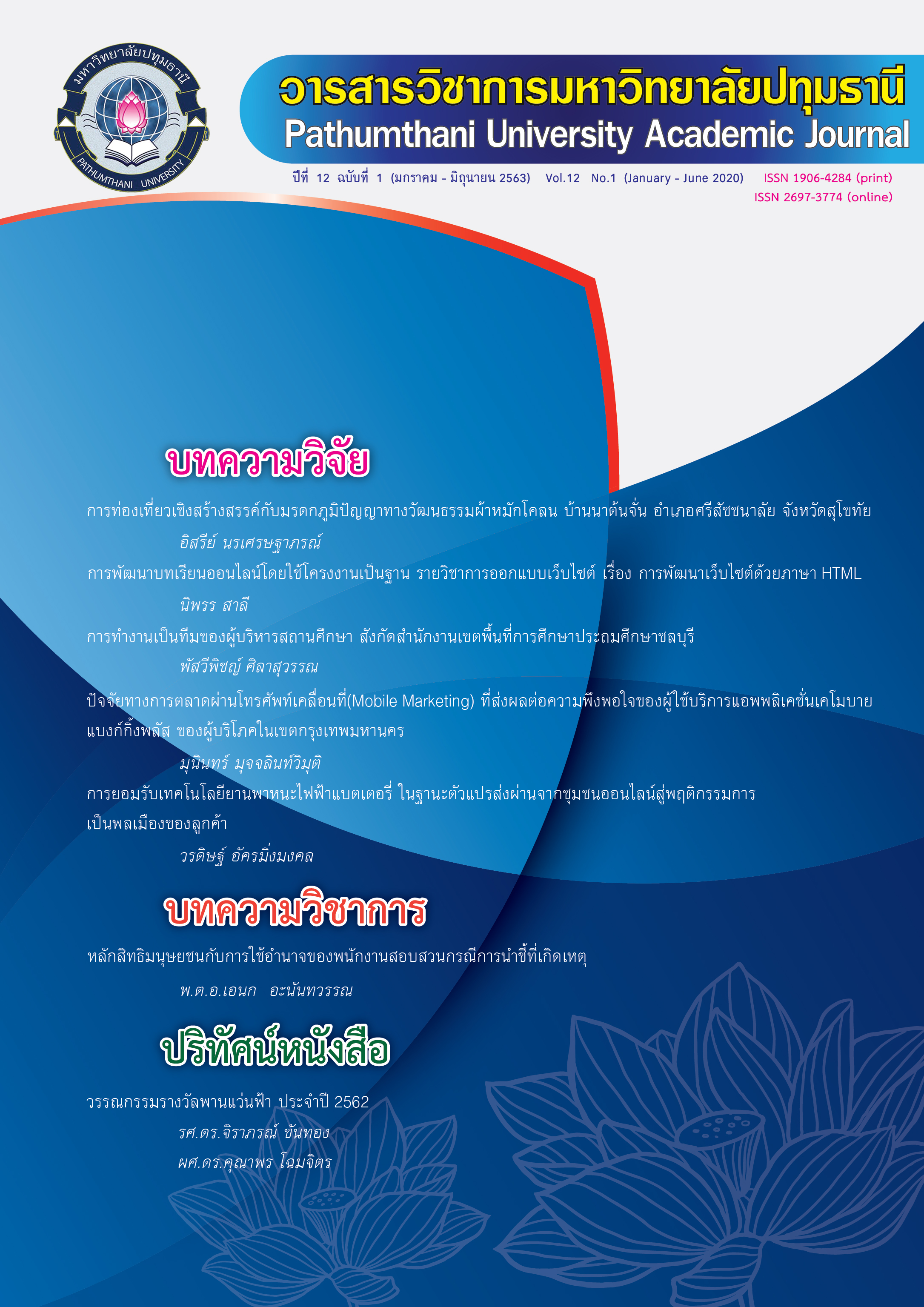ORAGANIZATIONAL CLIMATE IN THAI PRIVATE HOSPITALS IN THE EASTERN REGION OF THAILAND
Keywords:
Organizational climate, Practices and techniques, Thai private hospitals, The Eastern region of ThailandAbstract
This reThis research aimed at explored dimensions of organizational climate, practices and techniques operated to enhance the positive organizational climate, and investigated benefits in selected private hospitals accredited with HA standard recognition in the Eastern region of Thailand. The design of this study is qualitative research. About 5 HR managers and 1 deputy managing director having at least five years of work experience in Thai private hospitals accredited with HA standard recognition. Purposive sampling technique was used to identify the participants. The data collection method in this study is a semi-structured interview. To code and categorize the gained data systematically, ATLAS.ti 6.2 which is the qualitative software for data analysis was performed to pattern the themes. This study revealed that there were 5 dimensions of organizational climate. These include 1) Having charismatic leadership, 2) Pleasant workplace providing good safety and work-supporting facilities, 3) A staff caring workplace, 4) A workplace promoting open communication, and 5) Workplace unity, rules and regulations. The study found that the HR managers in hospitals use of six practices and techniques which were shared: 1) Going through five steps of organizational climate process, 2) Arranging engagement activities, 3) Cultivating valuable spiritual awareness, 4) Scheduling and calling of meetings, 5) Managing staff diversity, and 6) Noticing and addressing problems. Four benefits gained from having the current organizational climate in place consisted of, 1) Impressing customers through excellent standards of service quality, 2) Ensuring a high rate of staff retention, 3) Being able to notify problems and providing quick response, and 4) Reducing recruiting and training costs for training new employees.
References
Aarons, G. A., Woodbridge, M., & Carmazzi, A. (2002, March). “Examining leadership, organizational climate, and service quality in a children’s system of care”. Paper presented at the 15th Annual Research Conference. A System of Care for Children’s Mental Health: Examining the Research Base, Tampa, FL. pp. 15-18.
Briggs, R., O., & Vreede, G., J. d., (1997). Meetings of the Future: Enhancing Group Collaboration with Group Support Systems, Creativity and Innovation Management. 6(2): 106-116
Figueiredo-Ferraz, et al., (2012). Burnout and job satisfaction among nursing professionals, US National Library of Medicine National Institutes of Health, 24(2):271-6
Gershon, R., Stone, P.W., Bakken, S. and Larson, E. (2004). “Measurement of Organizational Culture and Climate in Healthcare”. Journal of Nursing Administration. 34 : 33-40.
Glisson, C., and James, L., R. (2002). “The cross- level effects of culture and climate in human service teams” Journal of Organizational Behavior. Vol. 23 No.6. pp.767-794.
Husserl, E. (1970). “The idea of phenomenology”. The Hague. The Netherlands: Nijhoff.
Mason, D.,C., & Aramovich, N., P.(2013). “The Psychological Benefits of Creating an Affirming Climate for Workplace Diversity”. Group & Organization Management. 38(6):659-689.
Musunuru, K. (2011). A Study on Patients Education and Its Impact on Health Satisfaction with Special Reference to Private Hospitals in Hyderabad. Health Care Management & Medico Legal System.
Neal, A. & Griffin, M.A., (1997). “Perceptions of Safety at Work: Developing a Model to Link Organizational Safety Climate and Individual Behavior”. Paper presented to the 12th Annual Conference of the Society for Industrial and Organizational Psychology. St. Louis, MO
Nishii, L.H. (2013). “The Benefits of Climate for Inclusion for Gender-Diverse Groups”. Academy of Management Journal. 56 : 1754-1774.
Rojas, D., Seghieri, C., Nuti, S., (2014). “Organizational climate: Comparing private And public hospitals within professional roles”. Suma Neg. Vol. 5 No. 11 : 10-14.
Schlosser, R., & Wendt, O. (2008). “Effects of augmentative and alternative communication intervention on speech production in children with autism: A systematic review”. American Journal of Speech-Language Pathology. Vol. 17 No. 3. 212–230.
Schyns, B., Van Veldhoven, M., & Wood, S. (2009). “Organizational climate, relative psychological climate and job satisfaction.” The example of supportive leadership climate. Leadership and Organization Development Journal. Vol. 30. pp. 649-663.
Thyer, B., A., (2002). Evidence-based practice and clinical social work Evidence-Based Mental Health. Vol. 5 No. 1 : 6-7
Torner, M., Pousette, A., Larsman, P., and Hemlin, S., (2017).” Coping with paradoxical demands through an organizational climate of perceived organizational support: An empirical study among workers in construction and mining industry”. The Journal of Applied Behavioral Science. Vol.53. 117-141.
Van Manen, M. (1990). Researching lived experience Human science for an action sensitive pedagogy. State University of New York Press, Albany.
Charoenarpornwattana, P. (2015). Workplace Spirituality in an organization: A Grounded Theory Approach. Doctoral dissertation. Burapha University
Downloads
Published
How to Cite
Issue
Section
License
บทความที่ได้รับการตีพิมพ์เป็นลิขสิทธิ์ของวารสารมหาวิทยาลัยปทุมธานี
ข้อความที่ปรากฎในบทความแต่ละเรื่อง เป็นความคิดเห็นส่วนตัวของผู้เขียน กองบรรณาธิการไม่จำเป็นต้องเห็นด้วยเสมอไป และไม่มีส่วนรับผิดชอบใด ๆ ถือเป็นความรับผิดชอบของผู้เขียนแต่เพียงผู้เดียว



